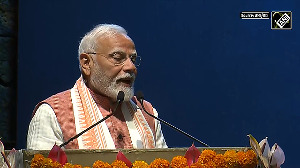Clever technocrats have ingenious ways of dressing up bad projects. One way is to declare that the problem project was only a 'pilot,' 'prototype', or the 'first phase' of a larger scheme, of which the 'second phase' will follow (at a higher expense, of course). India and the United States have played that very trick by announcing the end of the 'first phase' of the grandiosely termed 'Next Steps in Strategic Partnership,' NSSP -- launched less than a year ago -- and the beginning of the 'second phase.' Last week, US Under-Secretary of Commerce Kenneth Juster visited New Delhi to discuss the 'second phase' with Indian leaders.
Yet, going by past experience, and by US policy on defence-related matters, the 'second phase' may turn out to be equally unspectacular. The 'first phase' was to open up India's access to US nuclear and space exports and allow increased trade in 'dual-use' goods (which have both military and civilian applications).
But what did NSSP actually achieve?
At the end of the day, Washington lifted sanctions imposed after the Pokharan-II blasts upon Indian Space Research Organisation headquarters, relaxed licensing requirements for certain low-technology dual-use items for ISRO subsidiaries, and liberalised exports of some equipment intended for 'balance-of-plant' use at Indian nuclear reactors already under International Atomic Energy Agency, IAEA safeguards. ('Balance-of-plant' refers to the non-nuclear, back-end part of atomic power stations, like turbines, generators and control systems.)
This adds up to very little. ISRO headquarters performs an administrative role. The production functions are handled by its seven subsidiaries, which manufacture propulsion systems, rockets, satellites, etc. They remain sanctioned. The low-end items the subsidiaries import comprise all kinds of goods, from pins and clips, to third-country products using US-made silicon chips or software. Most of these are relatively easily available from alternative (including Indian domestic) sources. They don't contribute to high-technology trade -- promoting which is NSSP's rationale.
Finally, what of the relaxation of export controls in regard to nuclear power?
There are 115 items subject to such controls. Of these, 103 are already covered by multilateral controls under the Nuclear Suppliers Group (or the London Club). The remaining 12 are governed by US domestic laws. Only 4 of India's 14 nuclear power reactors can possibly import these 12 items: Tarapur I-II and Rajasthan I-II alone are subject to IAEA safeguards. Of the 12 items, only two are relevant for balance-of-plant use: generators and special-alloy valves. But several Indian companies make these!
So the new licensing regime is hardly 'liberal.' As if to rub in the point, Washington on September 29 imposed fresh sanctions on 14 Indian 'entities' on suspicion that these might have helped Iran develop mass-destruction weapons. They include two former chairmen of Nuclear Power Corporation (Y S R Prasad and C M Surender), one of whom visited Iran as part of an IAEA delegation!
NSSP's 'second phase' might at best see -- if India negotiates extremely hard -- some loosening of export controls on space satellites and components, which Washington treats as 'munitions!' But dramatic changes are unlikely. The US is bound by its domestic laws like the Non-Proliferation Act 1978 as well as its commitments to voluntary multilateral agreements like the NSG, Missile Technology Control Regime, the Wassenaar Arrangement and the Australia Group.
Washington has repeatedly said its 'strategic partnership' must be 'consistent with US domestic laws and national security and foreign policy objectives...' As former deputy secretary of state Strobe Talbott put it: 'Right now the US and India may feel that they are moving in the same direction but their destination could be different... There's this great fixation in India with NSSP, but it's going to set Indians up for a great disappointment... India and the US are not opening a new chapter, they are merely turning over a new leaf in the same chapter.'
There are four major lessons here.
First, the current discussion on NSSP is essentially a hangover from the previous government. The Vajpayee government showed irrational exuberance about 'strategic partnership' and minimised the asymmetrical, skewed nature of India-US relations. Talbott in his book Engaging India reveals that Vajpayee assigned a special role to his confidant Jaswant Singh just before the May 1998 nuclear tests. Breaking protocol, Singh called on President Clinton's special envoy Bill Richardson at the US ambassador's residence -- something senior ministers aren't expected to do. He conveyed the message that 'he was under instructions from Vajpayee to serve as a discreet -- and, if necessary, secret --
Neither such kowtowing, nor the 14 rounds of Talbott-Singh talks put India-US relations on an even keel or averted reprimand from the Security Council and the G-8. Even after bilateral relations improved after 2000 -- thanks largely to extraneous factors like the business success of Silicon Valley Indians -- their basic character didn't change. For all its rhetoric, Washington won't share high-technology goods with India nor agree to build an exclusive relationship -- even as it designated Pakistan a Major Non-NATO Ally.
Second, Jaswant Singh was misguided in rushing to welcome Bush's May 2001 announcement of plans to deploy a Ballistic Missile Defence (or 'Son of Star Wars') system to give the US a shield against alien missiles. He outdid even the ultra-loyal British. BMD will dangerously change the rules of the global nuclear-deterrence game. Singh's calculation -- he was in ecstasy when Bush 'dropped in' on him -- was that the US would share this extremely advanced, cutting-edge technology with India. The new US ambassador, David Mulford, has also since made alluring references to Indo-US cooperation on BMD having gone 'beyond mere talking.'
Singh made a huge, morally and militarily untenable, departure from India's established opposition to BMD and militarisation of space. His calculation was downright naïve. Washington is most unlikely to share with India -- and even with its European allies -- a cutting-edge technology such as detecting missile launches with satellites and then intercepting them at high speed -- akin to hitting a bullet travelling at 24,000 kmph with another bullet travelling at the same speed.
The US isn't sharing even the much simpler Theatre Missile Defence technology with a close military ally (Japan) for whom it is developing it. Besides, a regional TMD will neutralise Pakistan's missiles and create 'imbalance,' to 'correct' which Pakistan will want its own TMD.
Third, if Indian policymakers really think that friendship/partnership with America will help India enter the Nuclear Club, they are deluding themselves. There is no way that the US can dispense with the existing global non-proliferation regime (of which only India, Pakistan and Israel have stayed out). The US may not fulfil its obligations under NPT to disarm nuclear weapons, but it sees the treaty as a bulwark against the spread of nuclear weapons.
The NPT cannot be opened up for signature to more nuclear weapons-states (barring the 5 which conducted nuclear explosions before 1967). It could be amended to permit an additional protocol for India's and Pakistan's signature. But such a '5+2' formula would oblige India and Pakistan to accept additional arms control measures -- including limitations on fissile material production. But that's precisely what India has been trying to avoid. This would be a fool's bargain.
We must pause and think about what kind of high-technology or dual-use goods we really need. We have long attached iconic, totem-like value to technology for its own sake. For years, India begged the US to sell it a Cray-XMP supercomputer. One such processor was procured. But it sat for years in the Meteorological Department, and has added nothing to the quality of our monsoon forecasts!
Meanwhile, India's Centre for Development of Advanced Computing produced the even faster PARAM! Do we really want America's nuclear power technology, which has proved a market failure? In the US, no new reactor has been ordered for 26 years. Is nuclear power the path to energy security, rather than renewable sources, including biomass, wind, and solar?
Finally, there are irreconcilable, fundamental differences between Indian and US views of and plans for the world. The US aspires to Empire and domination. It wants to reshape the world by changing the rules of international politics. India's interest lies in a multi-polar world where might is not right, and peaceful resolution of disputes is possible. For the US, nuclear disarmament isn't a long-term goal; it's at best a legal and moral obligation to be ducked or defied.
For India, disarmament was an ideal for 50 years -- until the NDA violated it. It still remains a long-term objective, and a precondition for a peaceful world. The US imposes unequal trade and investment policies on the world through the WTO and the World Bank/IMF. India declares victory when it can resist these, as it did at Cancun!
There is a limit beyond which India and the US cannot be partners. They can reduce friction in their relations and reach understanding on a few issues. They can certainly improve their economic and political relations. But 'strategic partnership' is an illusion.






 © 2025
© 2025